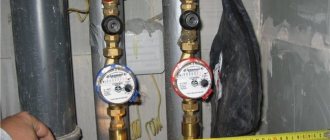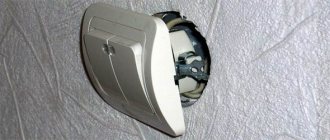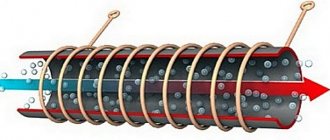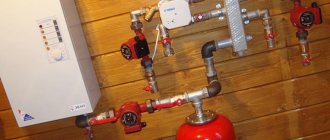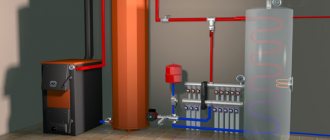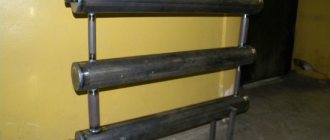All water heating systems can be divided into two-pipe (radiators are connected in parallel) and single-pipe (radiators are arranged in series). Moreover, each type has its own advantages and disadvantages. For private houses and apartments where heating is arranged independently, they usually prefer the single-pipe option in its most successful form - the so-called “Leningradka”.
Main characteristics:
- the presence of one main pipe;
- connecting all radiators in series;
- mandatory presence of a bypass (jumper) under the radiator for a more uniform temperature distribution in the system;
- the ability to choose a horizontal or vertical layout;
- forced or natural circulation of coolant.
Below is a typical diagram of a single-pipe heating system “Leningradka”.
Design
The simplest version of the system consists of the following elements:
- Expansion tank . It is a reservoir with coolant. Installed above the heating elements and boiler to ensure water circulation through the pipes.
- Boiler . Connects directly to the expansion tank and the upper circuit. Heats up the coolant.
Leningrad heating system diagram
- Upper outline . Supplies hot water from the boiler to the tank and heating elements.
- Bottom outline . It removes the cooled coolant from the heating elements to the boiler for subsequent heating.
The main feature of the Leningradka is that the heating elements are not connected to the upper circuit in series, but are installed parallel to it. This is the main difference from a conventional single-pipe heating system.
Main varieties
The types look like this:
| View of the Leningrad system | Description | Flaws |
| Horizontal | The main feature is the location of the radiators. They must be on the same line. The 1-pipe system is mounted slightly above floor level. Attention is also paid to the internal and “underground” parts. This accompanies an improvement in aesthetic qualities. In this case, there is nothing complicated in caring for pipes. | Heat is lost during hidden installation. There is a need for thermal insulation. |
| Vertical | It is formed by a highway laid in the attic. Pipes descend from it and supply water to the radiators. Installation is carried out next to the windows. The highway itself needs to be installed at a slight angle. The optimal solution is to use pipes with an impressive internal cross-section. | The “main” pipe passing through an unheated room requires insulation. If the circuit becomes more complex, it becomes necessary to adjust the resistance (hydrodynamic). Needle valves can come to the rescue. They can be replaced with a pump. The appearance is not so aesthetically pleasing. Communications are “hidden” with great difficulty. |
Important! There are also other types of combinations. They differ in the type of circulation and decoupling.
Principle of operation
The principle of operation of the “Leningradka” is generally no different from that in any single-pipe heating system.
The system operates as follows:
- the boiler heats the water and supplies it partially to the upper circuit, and partially to the expansion tank (excess coolant goes there;
- the heated coolant is lighter than the cold one, so it rises into the battery, displacing the cold one down;
- in the battery, the water gives up its heat and is itself displaced by the hotter one, which just came from the boiler;
- the cooled coolant enters the lower circuit, which leads to the entrance to the boiler;
- after cold water enters the boiler, the cycle repeats.
Methods for connecting a radiator to the main line
The heat transfer of radiators depends on the method of their connection to the main line.
There are three main types of connection:
- Diagonal;
- Lateral;
- Lower.
Let's look at the features of each of these methods in more detail.
Diagonal or cross connection
Diagonal, or cross, connection is the most effective. Maximum heating of the battery area is achieved, and there is practically no heat loss.
According to this scheme, the supply pipeline is connected to the upper radiator pipe, and the outlet pipe is connected to the lower pipe located on the opposite side of the device. For devices with a large number of sections, only the diagonal connection type is used.
Lateral or one-sided connection
Lateral, or one-sided, connection allows for uniform heating of all sections of the device.
For connection, the supply and discharge pipelines are connected on one side. Most often, this connection is used for heating installations with overhead wiring.
Heating heat transfer when radiators are connected sideways, with supply from top to bottom, is 97%. With the reverse movement of the coolant - from bottom to top - this figure is 78%
Bottom connection of radiator with pipeline
Bottom connection is not the most efficient heating scheme. However, it happens quite often, especially when the main pipeline is hidden under the floor.
The inlet and outlet pipes are connected to the lower pipes located on different sides of the radiator.
The heat transfer rate with bottom connection of radiators is 88%
Pros and cons of the system
The advantages of “Leningradka” include:
- Simplicity . Despite some complications compared to the traditional single-pipe system, the Leningradka is very simple. Its installation can be done even by someone who does not have specific knowledge and skills in the relevant field.
- Economy . 20% - 30% less material is spent on “Leningradka”. But here we immediately need to make a reservation - the advantage is only relevant in comparison with a two-pipe system. If you take a single-pipe one, then it will turn out to be even somewhat more economical (due to the fact that the batteries are connected in series and no taps are made to them).
- Possibility of fine tuning . If you install a needle regulator on each bypass, it becomes possible to regulate the temperature of an individual battery.
- Easy to maintain . If we are talking about a traditional one-pipe system, to replace the battery it will have to be completely freed from water. In the case of the Leningradka, this is not necessary - it is enough to shut off the bypass. Water will continue to circulate along the lower circuit. True, for such an opportunity to arise, it is necessary to equip the bypasses with taps.
Expert opinion
Grebnev Vadim Savelievich
Heating system installer
Another plus is versatility. “Leningradka” can be implemented anywhere: in a country house, one- or two-story cottage. And even in a city apartment.
However, the system also has disadvantages. Here are the main ones:
- Uneven heating of radiators . Even a needle valve in the bypass does not solve the problem. True, it does not occur with all types of connections. But more on that later.
- Inability to connect additional heating equipment . For example, heated floors. But this is not a disadvantage exclusively of the “Leningrad” - the minus is typical for any single-pipe heating.
- The need to use large diameter pipes . The minimum should be at least 2.5 cm. If you take less, it will be difficult to select suitable bypasses for radiators. Because of this, the pressure in the system often drops. As a result, water cannot circulate normally. The problem is solved by installing pipes of smaller diameter, which create the required pressure.
Pipe diameter
The general circuit closed on the boiler is made of a pipe of larger diameter - one inch or more. Elbows for connecting radiators – ¾ inches. Heat distribution occurs due to the pressure difference in the common pipe and radiator, as well as convection, because the coolant cools much faster in the radiator.
The water flow is divided in two between the bypass and the radiator. The proportions in which the hot coolant enters the heat exchanger or bypasses it along the jumper depend on the resistance of the radiator and bypass. The problem is solved by selecting the diameter of the pipes. If the main line is made with a large diameter and, accordingly, throughput, then the bypass is laid with the same smaller diameter as the pipes to the radiator.
A simple and cheap option, although it requires a little more time for installation and the number of adapters, it significantly compares the temperature along the entire length of the circuit.
If for some reason it is impossible to lay the pipe in a single circuit throughout the building, additional circuits of shorter length are formed. It is also necessary to balance the distribution of the coolant between the circuits, otherwise it is possible that all the hot water will simply bypass the larger circuit, because it has a higher resistance.
It is no longer possible to solve this problem by selecting the diameter of the pipes. It is necessary to use a needle valve installed on the return of the smaller circuit.
Type selection
Vertical connection
First you need to decide on the type of “Leningradka”. The differences come down solely to the type of battery connection.
Depending on this criterion, four types of system are distinguished:
- with bottom connection;
- with vertical connection;
- with top connection;
- with diagonal connection.
The lower one normally warms up only half of the battery. In addition, when using them, difficulties with coolant circulation may occur. They are solved by connecting an electric pump that will pump water through the system. But this reduces the advantages of the Leningradka to nothing. After all, the pump increases energy costs. Yes, and you will have to buy the device itself.
The best option is a vertical connection. It ensures uniform distribution of water in the system, which gives the best heating of the radiator. The diagonal connection has similar characteristics.
The top connection can also work without a pump. But during installation it is necessary to correctly determine the geometry of the pipes. If the acceleration section is assembled incorrectly, there will also be problems with water circulation. Proper installation requires a little more consumables. This also eliminates the advantages of the system over traditional options.
What is the device
"Leningradka" is distinguished by the presence of horizontal lower wiring. Heating devices can be connected on both sides of the pipeline.
"Leningradka" is the optimal solution when it is necessary to heat small houses
The system “behaves” best in 1-2-story buildings. The recommended number of radiators is 5.
The advantages look like this:
- possibility of simultaneous connection to 2 devices at once;
- the ability to lay the supply pipe under the door openings;
- aesthetic appearance;
- efficiency;
- ease of installation (lowest labor intensity).
The system is not without its shortcomings. The main disadvantage is the difficulty of dismantling if metal pipes were used during horizontal heating.
Materials
When choosing pipes, it is important to know the number of radiators
The choice of pipes to create a system depends on:
- number of radiators;
- warming up the system.
The diameter of the pipe must be such as to provide the required number of batteries with coolant. The more there are, the wider the gap should be. For 4 radiators you need at least 2.5 cm. For 5 - 6 - approximately 2.7 - 2.8 cm.
Expert opinion
Grebnev Vadim Savelievich
Heating system installer
If you do not plan to include a pump in the system, then the pipe diameter must be at least 40 mm.
Depending on the heating, the pipe material is selected. If the water in the system reaches a temperature above 90 ° C, it is better to use steel. The fact is that polypropylene melts already at 95o C.
Radiators are selected based on their operating efficiency. They must have maximum heat transfer. This is especially important because slightly cooled water enters the last batteries of the circuit. So for complete heat transfer they must have high efficiency.
Approximate calculation of the Leningrad heating scheme
Using the calculation example, it will be easy to see that designing this system is really not difficult.
Basic data for calculation:
- area of the building/apartment broken down by individual premises;
- ceiling height;
- information about the orientation of the external walls of the premises to the cardinal directions and the number of such walls;
- number, type and size of windows and doors.
A table for calculating a one-story house according to the proposed layout may look like this.
The required heating output is calculated using an online calculator for a ceiling height of 2.5 m and an outside temperature of -15 degrees Celsius. We believe that the thermal insulation of the walls is good, and there is a warm attic above the rooms.
| Room | Area, sq.m. | Presence and orientation of external walls | The presence of a balcony or entrance door | Availability, type and size of window | Required heating power, kW |
| Tambour | 5,45 | Three, S, E, W | Entrance | Single, double glazing, 1000x1500 mm | Not heated |
| Bathroom | 6,3 | Two, Yu, Z | No | Single, double glazing, 700x500 mm | 0,5 |
| Bedroom | 11,96 | Two, Z, S | No | Single, double glazing, 1500x1500 mm | 1,07 |
| Living room-kitchen | 23,02 | Two, S, B | No | Two, double-glazed windows, 1500x1500 mm | 2,05 |
| Utility room | 4,48 | Two, V, Yu | No | Single, double glazing, 700x500 mm | 0,36 |
| Total | 2,98 | ||||
With such low heating needs, the number of radiators for each room (except technical) is taken one at a time; the number of sections of bimetallic radiators is determined using an online calculator.
For the bathroom you will need 4 sections, for the bedroom 8, for the living room-kitchen 16. Considering that there are two windows in the living room, it is reasonable to divide the heating into two radiators - under each window, distribute one radiator of 8 sections.
Important: this calculation gives an approximate and, with a high degree of probability, an underestimated value of the required power of heating devices. It is advisable to increase the numbers by 10...15%.
Thus, we can assume that the bathroom will need 5 sections, in the bedroom and kitchen-living room - 9 instead of 8. However, radiators are usually produced with an even number of sections, so we accept 6 for the bathroom, 8 for the bedroom, 8 and 10 for the kitchen -living room
Next, you need to determine the total volume of coolant. To do this, you need to know the internal volume of each radiator, boiler and pipes. Without an accurate plan for laying communications and knowledge of the passport data of the battery and boiler models, this calculation cannot be performed. The volume of the expansion boiler is also added here, approximately 15% of the total volume of coolant in the system. Taking the data on average, we can assume that an electric boiler with a power of 6 kW has an approximate volume of 7...10 liters, the total volume of radiators at the rate of 0.39 liters per section is 13.5 liters. We add here the internal volume of the pipes and expansion tank - we get approximately 35...45 liters of coolant.
Carrying out work
Once you have decided on the connection diagram and selected materials, you can begin work on assembling the system.
They consist of the following stages (using the example of vertical connection of radiators):
- Preparation. At this stage, pipe holders are installed. If you plan to hide it in the walls, prepare grooves.
- Boiler installation. Install a heating boiler.
- Laying the main line. Two pipe circuits are laid from the boiler: upper and lower.
- Bends are made in the upper circuit. If we are talking about polypropylene pipes, then bends are created using tees. If the pipes are metal, then a hole is made in them, into which a bypass of smaller diameter is welded.
- If necessary, taps are installed in the bypasses to shut off access to the coolant or regulate the temperature of the battery.
- Radiators are connected to the bypasses.
- An expansion tank is connected to the outlet of the upper circuit of the system.
That's it, the work is finished. You can fill the system with water.
Coolant circulation
The coolant used is water, alcohol solution or antifreeze. Movement through the pipes is provided both natural and forced - with one or more pumps.
Natural circulation
Gravity flow is ensured by the properties of a liquid to expand with increasing temperature. In the boiler, hot water, since it has a lower density, is forced out by cold water to the top, and movement through the system begins. Cooling down and increasing in density, it tends to the starting point, to the boiler. This closes the circuit.
The pressure is provided:
- The temperature difference between the system and the room. The cooler the house, the faster the hot liquid moves.
- The difference in installation height of the boiler and the lower line with heating devices. They always try to place the heater lower (basement, ground floor), and the greater the height difference - from 3 m, the greater the speed of movement of the coolant. In small buildings, this condition is neglected due to the correct selection of the sizes of structural elements.
To reduce pipe resistance, horizontal sections are placed at a slope in the direction of water movement. The top point of the diagram is the open expansion tank. With proper assembly, the occurrence of air pockets in the batteries is eliminated; they are naturally forced into the tank.
The circulation rate is affected by:
- The diameter of the distribution pipes - products are selected with an increased internal cross-section to reduce resistance to fluid movement. The Leningrad heating system has diameters of the bypass and pipes that are 2 times smaller than the internal cross-section of the main channel.
- Choice of material. The pipeline with a polypropylene pipe was recognized as the best. The throughput of synthetics is several times higher compared to steel products of the same diameter. This is explained by the resistance of polypropylene to lime deposits and corrosion. Metal-plastic is not recommended.
- The complexity of the circuit is determined by the number of joints, transitions from one pipe diameter to another, the radius of turns, the type of shut-off and control devices. The greatest effect is achieved with linear placement of heating devices.
When adding additional circuits to the main structure, the installation of a needle valve must be taken into account. The regulator will balance the flow between polypropylene pipes of different diameters, heating will become more uniform. When circulating without a pump, the uninterrupted operation time of a system made of polymer, galvanized pipes with bimetallic heating devices is from 50 years.
However, the gravity flow scheme has its drawbacks:
- heating to the required temperature in radiators takes several hours, since initially the movement of cooled liquid along the line is slow;
- The length of the contour is limited - about 30 m.
Forced circulation
To increase the speed of the coolant, install a pump. Artificial acceleration of the liquid ensures rapid heating even with a small pipeline diameter, which is in demand for heating two-story houses no higher than 30 m.
Artificial flow promotion always has a closed type of system, that is, without air access. Since the only place of interaction with the external environment in structures is the expansion tank, for a closed type it is chosen to be sealed.
Stable pressure is determined by the type and power of the boiler, often the norm is within 1.5 atmospheres. Additional equipment that ensures the safe operation of the heating system of a two-story private house of the Leningradka type is:
- Pressure gauges - monitor and regulate the pressure inside the circuit;
- Safety valve - installed on the expansion tank; if there is excessive pressure, excess water is automatically discharged through it;
- Air vent - also located on the expansion tank, serves to extract air that is formed during the boiling of water in emergency situations of failure of the thermoregulation system.
It is recommended to install the pump at the point of the lowest coolant temperature - on the return circuit in close proximity to the boiler. This arrangement makes it possible to reduce the negative impact of hot liquid on the rubber gaskets of the device and thereby increase its maintenance-free operation.
“Leningradka” with a circulation pump operates on AC power. To ensure continuity of operation of the circuit during periods of power outages, install:
- Gasoline generator as a backup energy source.
- Bypass, with which you can transfer the system to natural circulation mode. To do this, shut-off valves are installed before and after the pump, one of which is equipped with a filter.
Shutting off the coolant is also necessary when it is necessary to clean or replace the coarse filter of the device or the pump itself, without interrupting the movement of the liquid along the main channel.
Nuances of the work
If the system does not have a pump, the upper circuit should be positioned with a slight slope
While working, you need to remember the following features:
- If metal pipes are used, internal beads must be avoided when welding. They reduce the internal clearance and interfere with the normal movement of the coolant. If there are swells, the system will not work normally.
- After filling the system, you should not immediately conduct a test run. Before it, you need to wait 3 - 4 hours and check all sections of the pipe, its connections with radiators, boiler, tank. This will allow the leak to be identified and repaired in a timely manner.
- Before a test run, it is necessary to remove air from the system using Mayevsky valves located in the radiators. Otherwise, it will only partially warm up (in the area up to the air bubble).
If the system does not have a pump, the upper circuit should be located with a slight slope (approximately 5 - 10o). This will facilitate the flow of coolant and prevent the problem of water stagnation in a certain section of the pipe.
Common installation mistakes
Above are “Leningrad” diagrams of horizontal single-pipe floor circuits with radiators connected to a common main line by two tees. Only part of the total volume of coolant circulating through the circuit flows through each device. You may encounter an erroneous connection without a main pipe (see the outline of the first floor in the figure below).
Types of connection of radiators in horizontal single-pipe circuits.
This method of connecting heating radiators is extremely cheap. Each radiator has one fitting for connecting a DN20 or DN25 metal-plastic pipe and a section of pipe between adjacent devices. Can't think of anything cheaper. But the price to pay for the cheapness is poor performance of half the radiators. The first of them (in the direction of the coolant movement) is heated to a temperature of 55 ° C, and the last one at N = 6-8 is heated to only 35 ° C, since the coolant, passing through the radiators, intensively cools down in them.
Questions and answers
Does it make sense to install a needle valve to regulate the temperature?
Yes, since the first radiator often gets too hot. The latter does not require a tap.
Is a pump required?
With a vertical connection - no. But if you incorrectly determine the angle of inclination of the upper circuit, water will not circulate normally through the system.
Is the temperature at the boiler outlet very different from the temperature at the last battery?
Yes. The difference can reach 45% - 50%. This is why it is so important to ensure proper coolant circulation.
Is it necessary to insulate the expansion tank?
Only if it's open. A closed one can work without insulation in an unheated attic.
Features of modernization
Today, the latest technologies are increasingly being used to improve the operation of devices long known to mankind, and thereby make life easier for people.
As a result, heating efficiency increases by 35%. Savings are 20-25%. Thanks to modern equipment, the installation operates stably. Safety during installation work is also guaranteed.
Today it is impossible to do without the Mayevsky crane
Modernized elements include:
- Mayevsky's tap is part of the battery. Designed for “manual” air extraction. To perform this task, automatic systems are used;
- balancers (thermostatic). Valves, valves and sensors are responsible for regulating the coolant flow. If the need arises, they help completely block the flow of fluid into the radiator;
- valves (ball). They are mounted on the outlet and supply of heating devices. Against this background, you can turn them off quickly enough. The operation of the entire system is not interrupted.
Reviews
- Konstantin, Tula region
“I have a small country house. I often go there in winter, so I installed gas and decided to install heating. The choice was made on the Leningradka. A two-pipe system is too expensive for me, and a single-pipe system is inconvenient - it is difficult to maintain radiators, and you cannot turn off a separate battery. I didn’t take the pump, I connected the radiators diagonally. I’ve been using it for almost the whole winter now, so far there have been no complaints - I’m happy with everything. I can say one thing: “Leningradka” fully met my expectations.”
- Ivan, Novgorod region
“We brought gas to my parents’ village house. The question arose about installing a heating system. We decided to make “Leningradka”. The house is small - there are only 6 radiators. There is no point in a two-pipe system. So far everyone is happy. It heats quite well (I connected the batteries vertically). It works great without a pump, although many say it is necessary. Separately, I would like to say about savings - the expenses turned out to be very small.”
In which houses is it beneficial to install single-pipe pumping systems?
A reduction in the length of heating pipes relative to two-pipe schemes is inherent in multi-storey residential buildings and industrial buildings (workshops, warehouses), characterized by heating circuit lengths of hundreds of meters. The use of “one-pipe” in them really saves heating pipes. Widespread use in individual construction is explained by a misunderstanding of the real cost-benefit ratio of this type of heating by customers and practical heating engineers.
In small two-story houses with an area of about 100 sq.m. (50 sq.m. on the first floor, 50 sq.m. on the second floor), a “one-pipe” is often installed, which works well with short circuits containing 4-5 heating devices. Large houses with many radiators are not well suited for single-pipe circuits, although objects with a dozen batteries in a floor circuit actually work, as in the mixed vertical-horizontal single-pipe circuit shown below.
Single-pipe system of mixed (vertical - horizontal) type.




